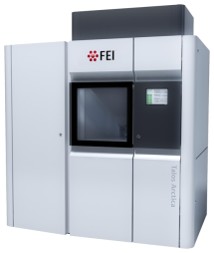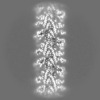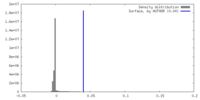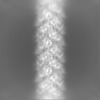+ Open data
Open data
- Basic information
Basic information
| Entry |  | |||||||||
|---|---|---|---|---|---|---|---|---|---|---|
| Title | Cuniculiplasma divulgatum filament | |||||||||
 Map data Map data | ||||||||||
 Sample Sample |
| |||||||||
 Keywords Keywords | cell surface appendage / N-glycosylation / PROTEIN FIBRIL | |||||||||
| Function / homology | Archaeal Type IV pilin, N-terminal / Archaeal Type IV pilin, N-terminal / Flagellin/pilin, N-terminal / membrane / Flagellin-like protein Function and homology information Function and homology information | |||||||||
| Biological species |  Cuniculiplasma divulgatum (archaea) Cuniculiplasma divulgatum (archaea) | |||||||||
| Method | helical reconstruction / cryo EM / Resolution: 2.61 Å | |||||||||
 Authors Authors | Isupov MN / Gaines M / Daum B / McLaren M | |||||||||
| Funding support | European Union, 1 items
| |||||||||
 Citation Citation |  Journal: ISME J / Year: 2025 Journal: ISME J / Year: 2025Title: Unusual cell surfaces, pili, and archaella of Thermoplasmatales archaea. Authors: Matthew C Gaines / Michail N Isupov / Mathew McLaren / Risat Ul Haque / Alejandra Recalde / Rafael Bargiela / Vicki A M Gold / Sonja-Verena Albers / Peter N Golyshin / Olga V Golyshina / Bertram Daum /   Abstract: Archaea of the order Thermoplasmatales push the boundaries of our current knowledge of prokaryotic life. They show distinct cellular plasticity, heterogenous cell morphologies, and lack a ...Archaea of the order Thermoplasmatales push the boundaries of our current knowledge of prokaryotic life. They show distinct cellular plasticity, heterogenous cell morphologies, and lack a paracrystalline S-layer. As the S-layer has previously been implicated in acting as a stator scaffold for filaments driving cellular propulsion, particularly archaella, we asked whether the absence of an S-layer precludes the formation of functional archaella or pili in Thermoplasmatales. Using cryoEM, we investigated the two Thermoplasmatales species Cuniculiplasma divulgatum and Oxyplasma meridianum. We found that these species indeed generate pili and archaella and that the latter likely function in cellular propulsion. Whereas C. divulgatum produces pili with terminal hooks using a unique assembly machinery, O. meridianum generates unusually wide, "barbed" archaella with a high degree of glycosylation. Our results show that for the generation of functional archaella and pili, a canonical S-layer is not necessary. | |||||||||
| History |
|
- Structure visualization
Structure visualization
| Supplemental images |
|---|
- Downloads & links
Downloads & links
-EMDB archive
| Map data |  emd_19112.map.gz emd_19112.map.gz | 51 MB |  EMDB map data format EMDB map data format | |
|---|---|---|---|---|
| Header (meta data) |  emd-19112-v30.xml emd-19112-v30.xml emd-19112.xml emd-19112.xml | 15.8 KB 15.8 KB | Display Display |  EMDB header EMDB header |
| FSC (resolution estimation) |  emd_19112_fsc.xml emd_19112_fsc.xml | 9.8 KB | Display |  FSC data file FSC data file |
| Images |  emd_19112.png emd_19112.png | 69.8 KB | ||
| Filedesc metadata |  emd-19112.cif.gz emd-19112.cif.gz | 5.6 KB | ||
| Others |  emd_19112_half_map_1.map.gz emd_19112_half_map_1.map.gz emd_19112_half_map_2.map.gz emd_19112_half_map_2.map.gz | 95.2 MB 95.2 MB | ||
| Archive directory |  http://ftp.pdbj.org/pub/emdb/structures/EMD-19112 http://ftp.pdbj.org/pub/emdb/structures/EMD-19112 ftp://ftp.pdbj.org/pub/emdb/structures/EMD-19112 ftp://ftp.pdbj.org/pub/emdb/structures/EMD-19112 | HTTPS FTP |
-Validation report
| Summary document |  emd_19112_validation.pdf.gz emd_19112_validation.pdf.gz | 822.8 KB | Display |  EMDB validaton report EMDB validaton report |
|---|---|---|---|---|
| Full document |  emd_19112_full_validation.pdf.gz emd_19112_full_validation.pdf.gz | 822.3 KB | Display | |
| Data in XML |  emd_19112_validation.xml.gz emd_19112_validation.xml.gz | 17.9 KB | Display | |
| Data in CIF |  emd_19112_validation.cif.gz emd_19112_validation.cif.gz | 23.4 KB | Display | |
| Arichive directory |  https://ftp.pdbj.org/pub/emdb/validation_reports/EMD-19112 https://ftp.pdbj.org/pub/emdb/validation_reports/EMD-19112 ftp://ftp.pdbj.org/pub/emdb/validation_reports/EMD-19112 ftp://ftp.pdbj.org/pub/emdb/validation_reports/EMD-19112 | HTTPS FTP |
-Related structure data
| Related structure data |  8reyMC  8rh5C M: atomic model generated by this map C: citing same article ( |
|---|---|
| Similar structure data | Similarity search - Function & homology  F&H Search F&H Search |
- Links
Links
| EMDB pages |  EMDB (EBI/PDBe) / EMDB (EBI/PDBe) /  EMDataResource EMDataResource |
|---|
- Map
Map
| File |  Download / File: emd_19112.map.gz / Format: CCP4 / Size: 103 MB / Type: IMAGE STORED AS FLOATING POINT NUMBER (4 BYTES) Download / File: emd_19112.map.gz / Format: CCP4 / Size: 103 MB / Type: IMAGE STORED AS FLOATING POINT NUMBER (4 BYTES) | ||||||||||||||||||||||||||||||||||||
|---|---|---|---|---|---|---|---|---|---|---|---|---|---|---|---|---|---|---|---|---|---|---|---|---|---|---|---|---|---|---|---|---|---|---|---|---|---|
| Projections & slices | Image control
Images are generated by Spider. | ||||||||||||||||||||||||||||||||||||
| Voxel size | X=Y=Z: 1.05 Å | ||||||||||||||||||||||||||||||||||||
| Density |
| ||||||||||||||||||||||||||||||||||||
| Symmetry | Space group: 1 | ||||||||||||||||||||||||||||||||||||
| Details | EMDB XML:
|
-Supplemental data
-Half map: #2
| File | emd_19112_half_map_1.map | ||||||||||||
|---|---|---|---|---|---|---|---|---|---|---|---|---|---|
| Projections & Slices |
| ||||||||||||
| Density Histograms |
-Half map: #1
| File | emd_19112_half_map_2.map | ||||||||||||
|---|---|---|---|---|---|---|---|---|---|---|---|---|---|
| Projections & Slices |
| ||||||||||||
| Density Histograms |
- Sample components
Sample components
-Entire : Cuniculiplasma divulgatum type IV filament
| Entire | Name: Cuniculiplasma divulgatum type IV filament |
|---|---|
| Components |
|
-Supramolecule #1: Cuniculiplasma divulgatum type IV filament
| Supramolecule | Name: Cuniculiplasma divulgatum type IV filament / type: organelle_or_cellular_component / ID: 1 / Parent: 0 / Macromolecule list: all |
|---|---|
| Source (natural) | Organism:  Cuniculiplasma divulgatum (archaea) Cuniculiplasma divulgatum (archaea) |
-Macromolecule #1: Flagellin-like protein
| Macromolecule | Name: Flagellin-like protein / type: protein_or_peptide / ID: 1 / Number of copies: 36 / Enantiomer: LEVO |
|---|---|
| Source (natural) | Organism:  Cuniculiplasma divulgatum (archaea) Cuniculiplasma divulgatum (archaea) |
| Molecular weight | Theoretical: 13.504127 KDa |
| Sequence | String: VSPIIATILL IAITVVLAAT LVTILGGFTH GVSNTVETAG VTSHITSKYI FINVSSSSSA ISASSITITI TGASFKVTSG DTLAEVAGV SSTSSNATFT GGSDYTVPIS LSSSQTVAGV SFELIYKGNV IYNSAA UniProtKB: Flagellin-like protein |
-Experimental details
-Structure determination
| Method | cryo EM |
|---|---|
 Processing Processing | helical reconstruction |
| Aggregation state | filament |
- Sample preparation
Sample preparation
| Buffer | pH: 1 |
|---|---|
| Vitrification | Cryogen name: ETHANE |
- Electron microscopy
Electron microscopy
| Microscope | FEI TALOS ARCTICA |
|---|---|
| Image recording | Film or detector model: GATAN K2 SUMMIT (4k x 4k) / Average electron dose: 51.4 e/Å2 |
| Electron beam | Acceleration voltage: 200 kV / Electron source:  FIELD EMISSION GUN FIELD EMISSION GUN |
| Electron optics | Illumination mode: FLOOD BEAM / Imaging mode: BRIGHT FIELD / Nominal defocus max: 2.0 µm / Nominal defocus min: 0.8 µm |
| Experimental equipment |  Model: Talos Arctica / Image courtesy: FEI Company |
 Movie
Movie Controller
Controller





 Z (Sec.)
Z (Sec.) Y (Row.)
Y (Row.) X (Col.)
X (Col.)





































